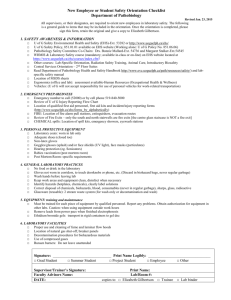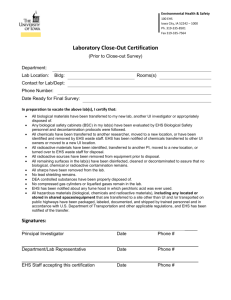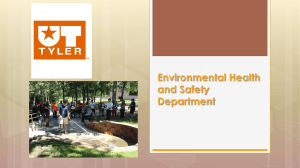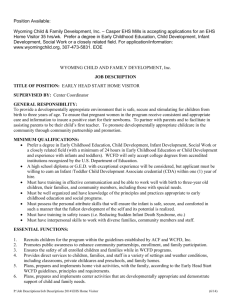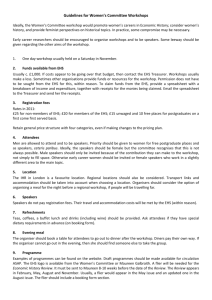Laboratory Relocation Guidelines for Virginia Tech March 2014
advertisement
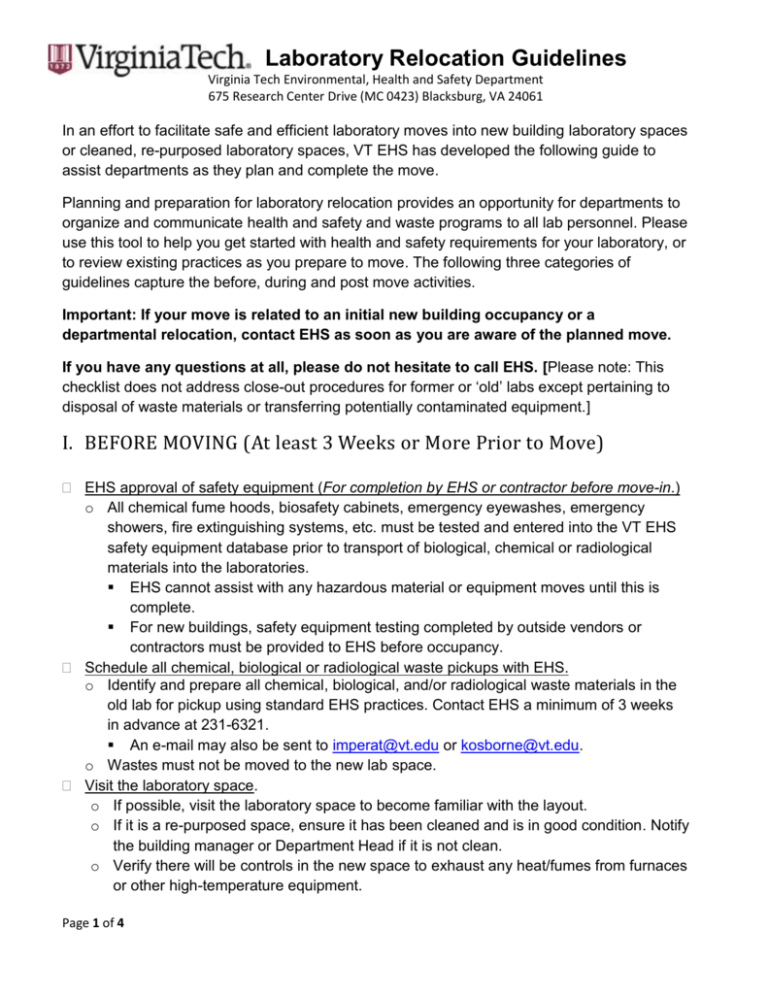
Laboratory Relocation Guidelines Virginia Tech Environmental, Health and Safety Department 675 Research Center Drive (MC 0423) Blacksburg, VA 24061 In an effort to facilitate safe and efficient laboratory moves into new building laboratory spaces or cleaned, re-purposed laboratory spaces, VT EHS has developed the following guide to assist departments as they plan and complete the move. Planning and preparation for laboratory relocation provides an opportunity for departments to organize and communicate health and safety and waste programs to all lab personnel. Please use this tool to help you get started with health and safety requirements for your laboratory, or to review existing practices as you prepare to move. The following three categories of guidelines capture the before, during and post move activities. Important: If your move is related to an initial new building occupancy or a departmental relocation, contact EHS as soon as you are aware of the planned move. If you have any questions at all, please do not hesitate to call EHS. [Please note: This checklist does not address close-out procedures for former or ‘old’ labs except pertaining to disposal of waste materials or transferring potentially contaminated equipment.] I. BEFORE MOVING (At least 3 Weeks or More Prior to Move) EHS approval of safety equipment (For completion by EHS or contractor before move-in.) o All chemical fume hoods, biosafety cabinets, emergency eyewashes, emergency showers, fire extinguishing systems, etc. must be tested and entered into the VT EHS safety equipment database prior to transport of biological, chemical or radiological materials into the laboratories. EHS cannot assist with any hazardous material or equipment moves until this is complete. For new buildings, safety equipment testing completed by outside vendors or contractors must be provided to EHS before occupancy. Schedule all chemical, biological or radiological waste pickups with EHS. o Identify and prepare all chemical, biological, and/or radiological waste materials in the old lab for pickup using standard EHS practices. Contact EHS a minimum of 3 weeks in advance at 231-6321. An e-mail may also be sent to imperat@vt.edu or kosborne@vt.edu. o Wastes must not be moved to the new lab space. Visit the laboratory space. o If possible, visit the laboratory space to become familiar with the layout. o If it is a re-purposed space, ensure it has been cleaned and is in good condition. Notify the building manager or Department Head if it is not clean. o Verify there will be controls in the new space to exhaust any heat/fumes from furnaces or other high-temperature equipment. Page 1 of 4 Laboratory Relocation Guidelines Virginia Tech Environmental, Health and Safety Department 675 Research Center Drive (MC 0423) Blacksburg, VA 24061 Chemical Planning o Schedule transport of lab chemicals to new lab with EHS. EHS packs, segregates and transports chemicals to be moved. EHS will pick up from multiple locations in the old lab but then unloads to a bench top in the new space for lab personnel to properly segregate, store, and manage chemicals. o Request vendor pickup of empty gas cylinders prior to your move. Contact EHS if you have a cylinder with unknown contents. o Contact EHS for guidance regarding decontamination of perchloric or other contaminated chemical fume hoods before they can be moved. Biosafety Planning o Submit revised IBC Registration request for the new lab location. IBC approval must be received before work with potential infectious material or recombinant DNA begins. o Contact Biosafety at 231-3361 or cwakley@vt.edu for guidance regarding movement of all biological materials. o Contact Biosafety for guidance regarding decontamination of biosafety cabinets and recertification of biosafety cabinets (or certification of any new cabinets). Biosafety cabinets must be re-certified after they are moved and before biological materials can be used in the new lab. All biosafety cabinets must be tested and entered into the VT EHS safety equipment database prior to transport of biological materials into the laboratories. Radioactive Materials Planning o Submit a diagram of the new lab (with radioactive use space and proposed storage areas clearly marked) to the Radiation Safety Officer at smileydc@vt.edu. o Arrange for RSO visit to review the space. o RSO will approve new location and provide appropriate signage. o Request containers to pack radioactive items for move (any equipment cleared by lab that have radioactive labels removed can be moved without RSO assistance). o RSO will move containers to new building. Pressure Vessels and Autoclaves o Contact Risk Management at 231-7439 if any autoclaves or pressure vessels will be relocated or new ones will be installed. Risk Management maintains an inventory and is responsible for scheduling certifications. Laser Safety o Contact EHS if any lasers or UV sources will be relocated or new ones will be installed. Old or Damaged Equipment o Schedule old or damaged equipment to be repaired or transported to Surplus Property prior to the move. Do not leave damaged, obsolete, or otherwise unwanted items behind. Page 2 of 4 Laboratory Relocation Guidelines Virginia Tech Environmental, Health and Safety Department 675 Research Center Drive (MC 0423) Blacksburg, VA 24061 II. DURING THE ACTUAL MOVE-IN EVENT Housekeeping and General Safety o During the move, keep aisle ways uncluttered, reserving three feet of clearance in all aisle ways. o Maintain clear access to emergency equipment. o Do not block emergency eyewashes or showers or the location of spill kits. o Do not block access to fire extinguishers or other fire safety equipment. o Remember ceiling clearance requirements when moving items to shelves. o Do not block electrical panels or electrical disconnects. o Be sure EHS documentation including MSDSs/SDSs is accessible in the event it is needed. III. SETTING UP THE NEW LAB SPACE Post required signage o Hazardous work areas and equipment need to be posted for biohazards, carcinogens, radiation, lasers, and other potential chemical or physical hazards. Be sure door signage indicates where emergency and safety related documents will be located. o MSDS/SDSs, training records and your chemical Hygiene Plan, Biosafety Manual or any other EHS documentation should have a designated location within each lab so when it is needed it can easily be accessed. Consider what waste containers will be required in the new lab and where they will be located. o Request containers from EHS or purchase for lab. Emergency Planning and Chemical Safety Information o Update the Emergency Action Plan. o Update Chemical Hygiene Plan. o Review location of new safety equipment (emergency showers, eyewashes, and fire extinguishers) with lab personnel. o Designate and communicate who is responsible for weekly eye wash checks and monthly fire extinguisher checks for your lab. o Review spill procedures for necessary changes and designate new locations for spill supplies in the Chemical Hygiene Plan. o Designate a storage area for personal protective equipment in the lab. o Decide who will be the laboratory emergency contact(s) and ensure signage including contact numbers is posted on the door of the lab before occupancy. Page 3 of 4 Laboratory Relocation Guidelines Virginia Tech Environmental, Health and Safety Department 675 Research Center Drive (MC 0423) Blacksburg, VA 24061 Chemical Safety o Update the Chemical Registration System with new laboratory information and any changes to chemical quantities (See http://www.ehss.vt.edu/programs/chem_reg.php). o Be sure chemicals are segregated by hazard class. Alphabetical segregation does not ensure safety. o Spill kits / supplies should be visible and easily accessible. o Liquid chemicals should be stored on the lower shelves. o Check to be sure chemical storage shelves are well secured. o Corrosive cabinets should be designated for acids or bases. Inorganic and organic acids must be segregated in secondary containment within the acid cabinet. o Flammables must be stored in flammable cabinets. Storage of flammables outside of flammable cabinets must be kept to a minimum (No more than can be used in one day’s operation). o Secure compressed gas cylinders. Segregate incompatible gases such as oxidizers from flammables. Cylinders of oxidizers and fuel gases that are in storage (not in use) must be separated by at least 20 feet, or a noncombustible wall at least 5 feet high with at least a half-hour fire rating. http://www.ehss.vt.edu/programs/CGC_storage.php o Do not store high hazard materials or compressed gas cylinders next to doors to the hallway. Page 4 of 4
